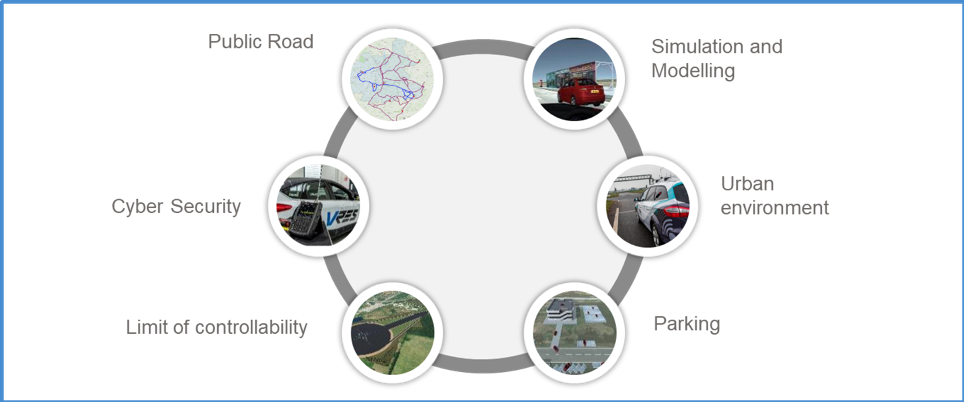This guest blog was written by Rob Capaldi, Commercial Manager – CAV at HORIBA MIRA (part of CAM Testbed UK).

An introduction to HORIBA MIRA
Established in 1946, HORIBA MIRA is a global provider of automotive engineering, research and test services. We work in collaboration with vehicle manufacturers and suppliers from around the world; providing comprehensive support for technology development, integration and verification through to full-vehicle development and certification.
We’re traditionally known for our vehicle test services – we have more than 40 major facilities and 100km of proving ground – but we’re so much more than this. Over the past 10 years we’ve invested heavily in the evolution of our engineering capability, particularly in the fields of energy efficiency, connected and autonomous vehicles and vehicle resilience. We’ve also invested in the development of MIRA Technology Park, our automotive R&D cluster.
We have worked on the development of connected and autonomous vehicles (CAVs) for over 15 years. In that time, we have been involved in pioneering research programmes and the development of purpose-built test facilities globally. We are now helping to usher these emerging technologies into the mainstream automotive environment through the development of a CAV test ecosystem, a co-ordinated range of engineering capabilities and test facilities that allow us to focus on validating and verifying CAV systems for the global automotive market, to ensure our customers’ solutions are safe, secure and perform successfully.
Our vision is to positively influence every journey in the world and our engineers are utilising the latest test facilities and simulation tools to improve lives by making journeys safer, cleaner and smarter.
What is our involvement in the CAM sector?
Our CAV team is currently active on a number of Centre for Connected and Autonomous Vehicles (CCAV) funded research programmes, contributing to the UK’s position as a leader in the development of CAV technology. One recent example is the HumanDrive project, which enabled us to develop our ability to replicate complex scenarios seen on public roads within the safety of our controlled environment proving ground. Another example is VeriCAV, a project led by the team at HORIBA MIRA, which is developing an advanced test scenario generation tool and test oracle.
Backed by this research, we serve a wide variety of global clients in the commercial sector, supporting a diverse range of projects including simulation, requirements capture and target setting, and delivery of physical tests. Throughout our work, we ensure there is a strong link between initial system requirements and engineering targets, and the verification methods required to ensure these targets are met.
How are we involved with CAM Testbed UK?
Our work with Zenzic as part of CAM Testbed UK is closely aligned with the application of a scenario-based testing approach; the facilities we are constructing on our site, in partnership with Coventry University, allow us to replicate a number of key scenarios.
Our ‘controllability’ facility developed as part of the TIC-IT project, will allow us to test vehicles to understand the performance when a challenging scenario is experienced at the limit of controllability – providing a critical link between our advanced technology knowledge in the CAV team and our experience developing the dynamic performance of road vehicles. Most testing of CAV systems takes place at relatively low speeds and not at the edge cases of operation. This facility will allow us to widen the range of tests possible to replicate scenarios that are difficult or inappropriate to perform on existing facilities or in public environments.
We are building a controlled parking environment within our urban driving circuit. This will allow us to test one of the early self-driving applications for passenger cars – autonomous valet parking (AVP). We will be able to test AVP systems in a variety of re-configurable parking areas with a high level of connectivity to validate both the on-vehicle technology and the interaction with the systems that process the parking transaction. We will be able to replicate the critical ‘last mile’ inner city environment with several key updates being made to the circuit, alongside the addition of the parking infrastructure.
We are partners in the creation of a public road testbed in the West Midlands – the Midlands Future Mobility project – covering a wide range of potential public road use cases in mixed environments. This connection allows us to seamlessly transition from testing in controlled, repeatable ways on our controlled facility to testing in the highly variable ‘real world’ on the public roads.
What makes HORIBA MIRA unique?
These facilities are key components in the ‘CAV test ecosystem’ that HORIBA MIRA is actively developing. The facilities, combined with our engineering expertise, allow us to provide a turnkey service to support clients at all stages of their product development lifecycle. We provide support at the early stages of autonomous vehicle system definition and target setting and offer testing services in simulation, controlled environments and on the public road as part of development and sign off.
A key component of our CAV test ecosystem is the creation of accurate ‘Digital Twins’ to allow simulated testing to take place at all stages of development. It will be essential to ensure a high level of correlation between the physical facilities and the simulated environments.

Where is the industry heading?
As we move towards a future with a high level of connection between vehicles and infrastructure, and with an increased likelihood of self-driving vehicles interacting with regular road users, we must ensure the that the approval process for the sign-off of vehicle safety considers all activity throughout the development – not simply relying on the traditional sign-off approach of a ‘final test’ at the completion of the programme. This will include an audit of all testing that takes place during the development of the vehicle in simulation, on the test rig, using controlled environments and on the public roads.
The widely publicised ‘billions of miles’ needed to validate the systems will be unachievable, so we will see a natural increase in simulated testing as part of the development process and we should expect to see it form part of the approval process.
The increase in simulation will not replace physical testing, they will support each other. Physical tests will provide a key correlation to ensure simulation results are accurate and closely represent reality. The use of controlled environments will allow system performance to be analysed at the edge cases of operation in a safe and repeatable way.
We are seeing an increase in the number of trials of autonomous vehicles in public environments, with systems performing at SAE ‘Level 4’. As these trials move to become active deployments, providing a service to the public, we will see a change in the development of test plans completed by manufacturers to include the wide variety of tests discussed here.
HORIBA MIRA is ready for this change. We have access to key engineering skills and are developing leading facilities that are ready to help the global CAM sector develop solutions that are safe, secure and perform successfully.
Discover more about the HORIBA MIRA – Coventry University CAV Testbed here or contact the team at marketing@horibamira.com.


